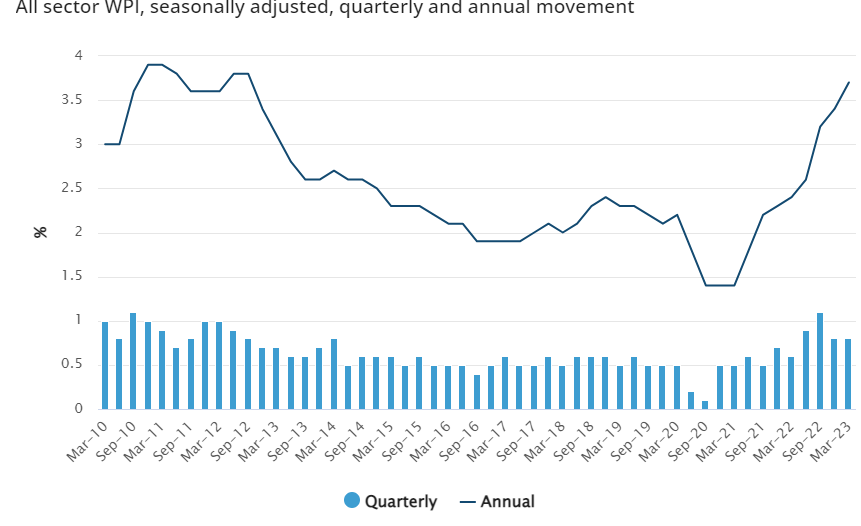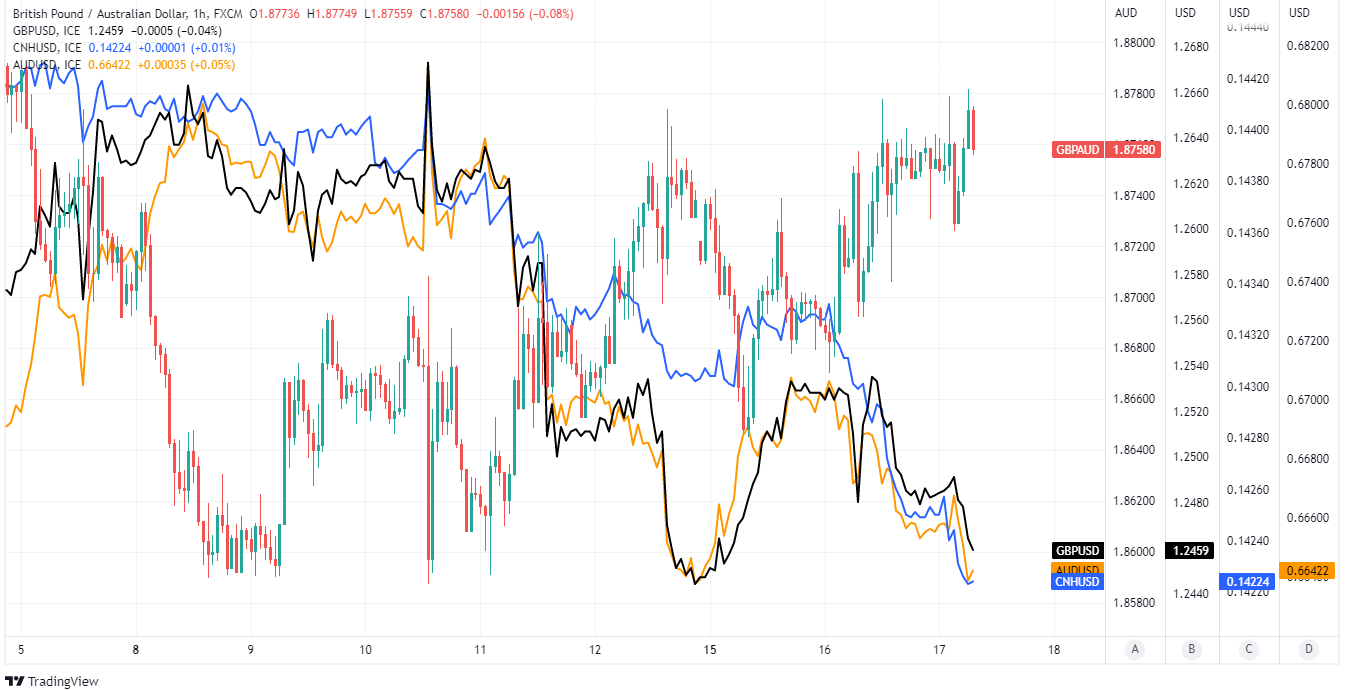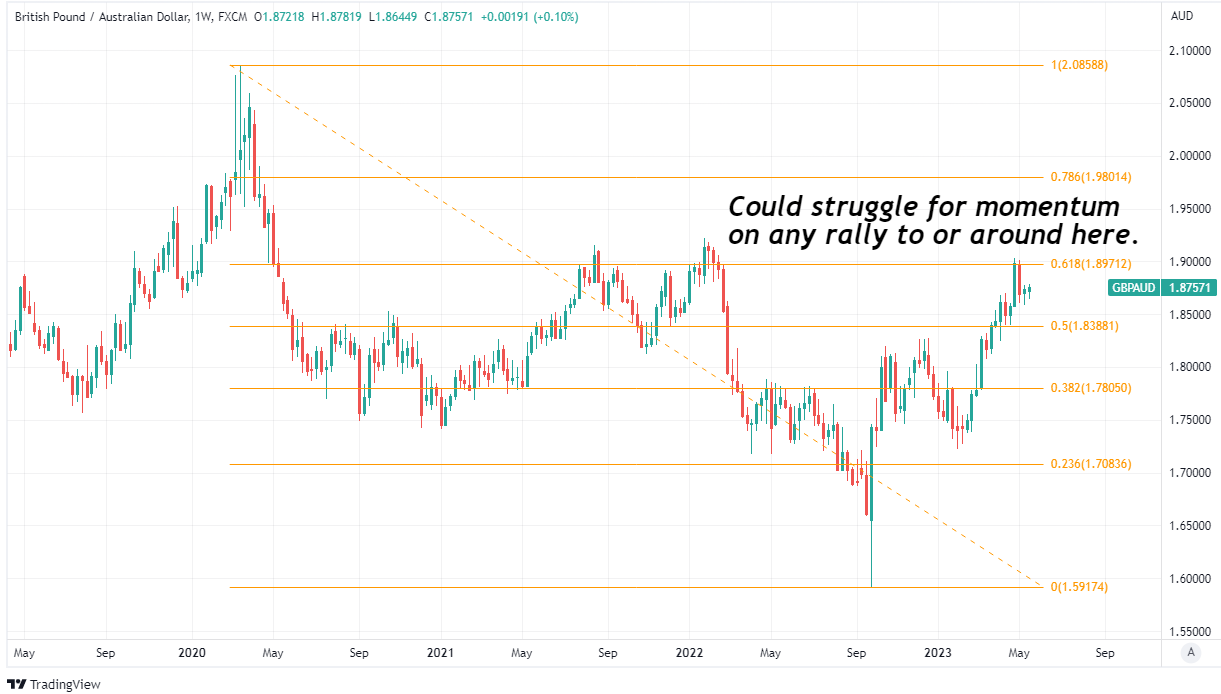GBP/AUD Rate Buoyed by Aussie Wage Data and Softer Renmnibi
"A related upside risk was the possibility that a prolonged period of high inflation leads to a shift in inflation expectations and a change in price- and wage-setting behaviour" - Reserve Bank of Australia.

Image © ArchivesACT, Reproduced under CC Licensing, Editorial, Non-Commercial
The Pound to Australian Dollar rate climbed in mid-week trade after an official measure of wage growth validated Reserve Bank of Australia (RBA) forecasts and as China's Renminbi appeared to lead other currencies lower when falling beneath another important level on the charts.
Australia's official measure of wage growth came in lower than had been expected by many economists when rising by an unchanged 0.8% for the opening quarter of the year, leading the annual measure to inch higher from 3.4% to 3.7% for the period.
Annual pay growth was a touch higher than expected by the consensus but closely aligned with the kind of increase illustrated in newly updated forecasts earlier this month, suggesting no immediate implications for Reserve Bank of Australia interest rate policy.
"Members noted that a range of indicators suggested that wages growth was running at an annual rate of around 3½ to 4 per cent in the March quarter. The Wage Price Index was expected to peak at around 4 per cent later in 2023, before easing slightly," minutes of the RBA's May meeting said on Tuesday.#
Wednesday's wage numbers were released barely a day ahead of employment figures for the month of April, which the consensus suggests will see employment rising by 24.8k to keep the unemployment rate steady at a record low of 3.5%.
 Source: Australian Bureau of Statistics.
Source: Australian Bureau of Statistics.
"Our Australian economics team note that there are signs that private sector wages growth is plateauing, supporting the view that the RBA cash rate has peaked at 3.85%," says Kristina Clifton, a senior economist and currency strategist at Commonwealth Bank of Australia.
"Australian employment is due a weak result following two very strong months of expansion. A weaker than expected result this month can see AUD/USD head towards downside support at 0.6595 (38.2% Fibbo)," Clifton writes in a Wednesday research briefing.
Moderating quarterly wage growth comes after minutes of the May monetary policy meeting revealed the RBA had been seeking to create a margin for error in its inflation forecasts when it surprised economists and financial markets by raising its cash rate to 3.85% earlier this month.
"Members observed that the forecast for inflation to return to the top of the target band by mid-2025 was predicated on productivity growth returning to around the modest pace recorded prior to the pandemic," the meeting minutes state.
 Above: Pound to Australian Dollar rate shown at hourly intervals alongside AUD/USD and CNH/USD. Click image for closer inspection.
Above: Pound to Australian Dollar rate shown at hourly intervals alongside AUD/USD and CNH/USD. Click image for closer inspection.
"If this did not occur, growth in unit labour costs would be uncomfortably fast. A related upside risk was the possibility that a prolonged period of high inflation leads to a shift in inflation expectations and a change in price- and wage-setting behaviour," the meeting record adds.
New forecasts suggested in this month's policy meeting that inflation is unlikely to return to the two-to-three percent target band until the middle of 2025 even with the latest increase in the cash rate, which was raised to 3.85%
This month's decision interrupted an earlier announced pause in the RBA's interest rate cycle or otherwise circumvented an earlier decision to end the cycle and Tuesday's meeting record confirmed this was due to concerns about the limited room for error in relation to the inflation target.
Thursday's data did nothing to suggest any further policy changes on the horizon for the RBA but didn't keep the Australian Dollar from falling alongside other currencies while lifting GBP/AUD, although that may have had more to do with ongoing falls in Chinese Renminbi exchange rates.
 Above: Pound to Australian Dollar rate shown at daily intervals alongside AUD/USD and CNH/USD. Click image for closer inspection.
Above: Pound to Australian Dollar rate shown at daily intervals alongside AUD/USD and CNH/USD. Click image for closer inspection.
"The rebound from the low gathered momentum quickly and today, USD/CNH burst above 7.0000. Not surprisingly, upward momentum is strong and the risk for USD/CNH for the next month or so remains on the upside," says Quek Ser Leang, a market strategist at UOB.
The Renminbi fell widely in deepening losses after a series of important barometers of Chinese economic activity underwhelmed forecasts for the month of April, leading USD/CNH to rise above an important technical resistance level on the charts before Tuesday before surpassing 7.00 on Wednesday.
Many other currencies are often sensitive to the Dollar-Renminbi exchange rate but especially those of key trade partner economies like Australia, meaning there may be a risk of heightened volatility in the days ahead.
"There has also been spill-over weakness to other Asian currencies following on from sharp sell-offs yesterday in the Latam currencies of the Brazilian real and Chilean peso. The worst performing Asian currencies overnight have been the Malaysian ringgit and Indonesian rupiah," says Lee Hardman, a senior currency analyst at MUFG.
 Above: Pound to Australian Dollar rate shown at weekly intervals alongside AUD/USD and CNH/USD. Click image for closer inspection.
Above: Pound to Australian Dollar rate shown at weekly intervals alongside AUD/USD and CNH/USD. Click image for closer inspection.
"The weakness in Asian and Latam currencies reflects more unease amongst market participants over the strength of the economic recovery in China following the release yesterday of disappointing economic activity data for April," Hardman adds in Wednesday market commentary.
Renminbi losses have tended to benefit the U.S. Dollar and GBP/AUD in the past but to the extent that they reflect a controlled depreciation or devaluation on the part of local authorities, the opposite might be the case this time around.
Stimulating the Chinese economy through currency depreciation would necessitate losses against more than just the U.S. Dollar and so could be bearish for the greeenback as well as the positively correlated GBP/AUD.
A falling Renminbi exchange rate would also help other countries, economies and currencies to curb currently high rates of inflation through lower cost imports.
"I still don’t think the market has fully internalized or come to appreciate how much of a zilch the China reopening has become and how fast it has gone from 1⁄2 pound bacon, cheese, and mushroom burger to nothingburger," Spectra Markets' Donnelly says in Tuesday's am/FX daily macro diary.
